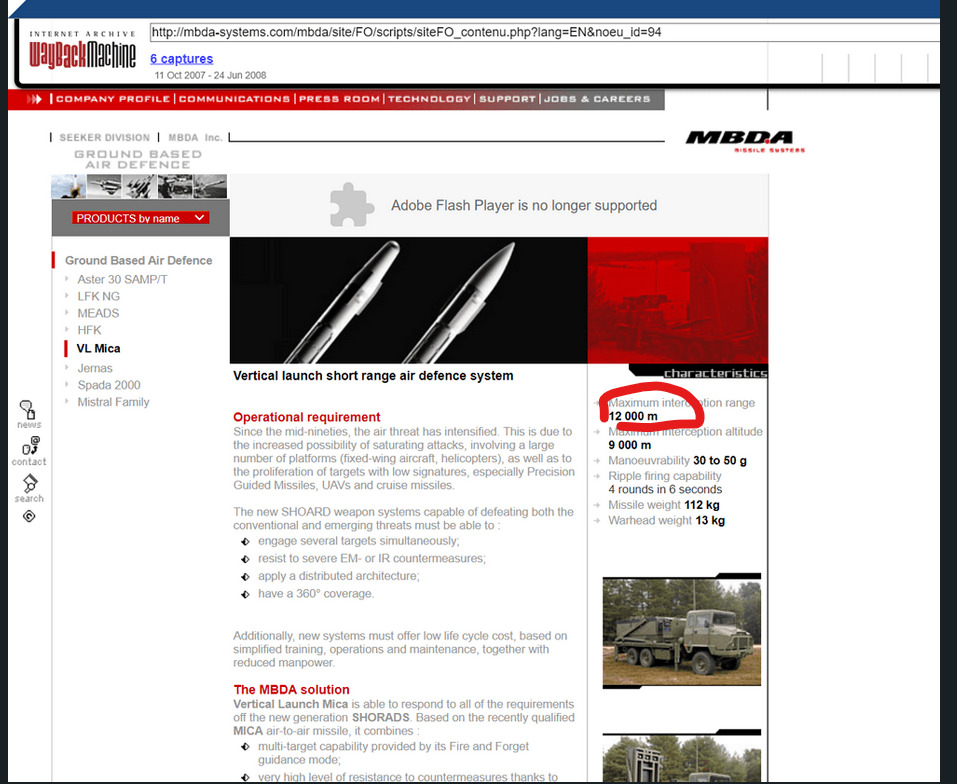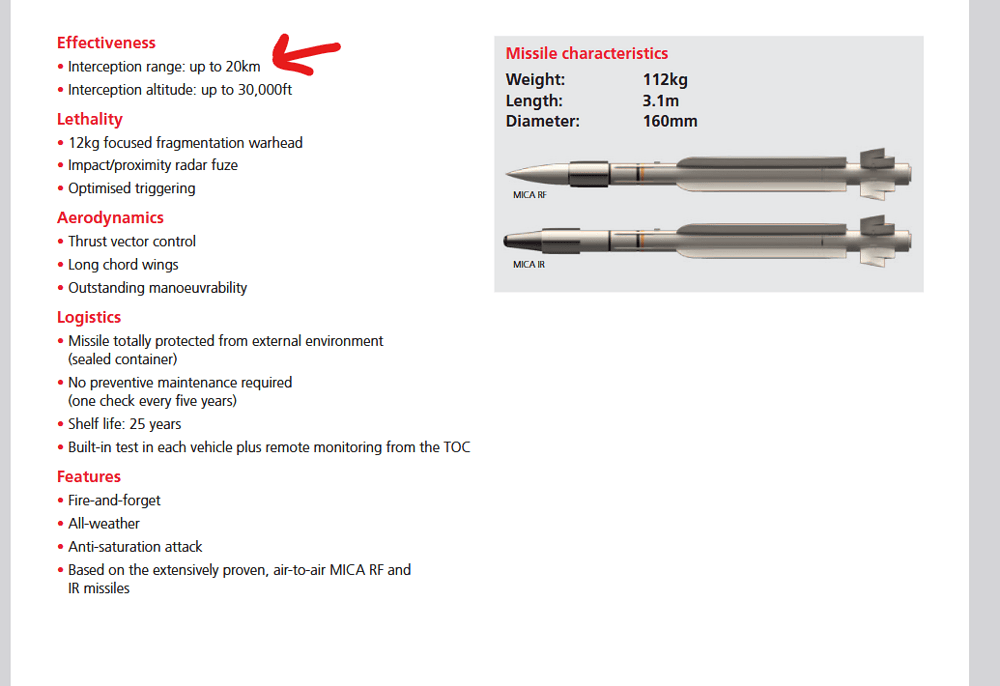This is using statshark, not perfect, but better than nothing.
MICA VL uses the exact same missile as the air launched version, its the name of the system, not the missile afaik. Pretty sure DS has made that point repeatedly.
MICA VL is the name of the system, not of the missile, and that’s what i was refering to, so i don’t really see your point
You said the 750m/s source was “quite old” gunjob mentionned it was from 2012 and newer than the 1000m/s source, you said the 750m/s source was for the MICA VL specifically, which should be irrelevant seeing as theyre the same missiles.
Maybe I misunderstood something, but saying the 2012 source refers to the VL MICA seems irrelevant to the discussion of 1000m/s vs 750m/s.
What i was stating was :
- Considering a Dv of 1000m/s
- Assuming said brochure from 2012 is correct, with a max speed of 750m/s (Mach 2.2)
→ This means a loss of speed of 250m/s due to drag alone
I will run an additional test on statshark tonight, but this would imply a drag coefficient so high the missile wouldn’t really reach 20km or even 80km, which contradicts other primary sources (such as this one : https://www.mbda-systems.com/sites/mbda/files/2024-06/2020%20VL%20MICA%20datasheet.pdf)
would be drag and gravity, with 90 degree VL launches either you use alot of energy to turn sharply(close range), or turn less sharp but have to climb and then descend(basically lofting), i seem to get about 820m/s with a MICA-IR representation which is still too fast.
80km might also be a high and fast launch. Where naturally there is a lot less drag and the missile is being launched with a healthy boost of energy and not a cold start.
Using SAMs for an air launched missile is tricky
Yeah, and doing so you would therefore have to add more drag go from 820 → 750
Look at how the missile behaves at longer ranges if you do that
note mica-ir is commonly listed as 60km not 80km.
Should’ve said it an other way, but let me rephrase :
“I will run an additional test on statshark tonight, but this would imply a drag coefficient so high the missile wouldn’t really reach 20km in VL or even 80km fired up high, which contradicts other sources (such as this one : https://www.mbda-systems.com/sites/mbda/files/2024-06/2020%20VL%20MICA%20datasheet.pdf)”
I’m not talking about MICA IR, but MICA EM
MICA IR will be draggier, as it should. For now though, the missile isn’t even in game so it isn’t really a concern
just clarifying, but yes there would need to be a pretty hefty drag penalty somewhere to drop to 750m/s
I’ll do more tests tonight, ran out of tests on stat shark for now
My understanding of what @Gunjob was saying is that the source claiming a dV of 1000m/s could be wrong seeing as its a requirement pre-dating the missile with no indication the requirement was met, while the 750m/s source is much newer and well into the missiles service.
Well, im not sure you can say that requirement is wrong. Requirement is a base, that can be met or not. That is why you need proof if it was met or not.
That is the point I was making yes. Happy to use requirements/specifications where there is evidence it met/got close to said requirement/specification.
I dont think it does. There is substantially more drag at sea level than up high, and you have the force of gravity, and you have the turn (which by the looks of things, the missile should have a shorter burn which would increase the impact this turn would have) and you have a static start (dont forget, It takes far more energy to get things moving than to keep something moving or accelerate it further usually)
So I think it could be perfectly accurate to state that “This missile launched from the ground looses energy WAY faster than if it was launched up high”
Though I still do not entirely beleive that the MICA EM had the kinetic performance to physically travel 80km, I’ve yet to see a single good source stated for that, and I dont think the current kinematic range performance is actually wrong, but i suspect the battery life is too short, meaning it could glide much further but wont be of much use at any greater ranges than it currently is
I mean, when there are 2 contradictory “primary” sources, one requirement pre-dating the missiles development, and a company statement made well into the missiles service life, the most obvious assumption to make is that the newer source is the correct one unless there is definitive proof that
A) The requirement set out by the first source was met
B) The newer source is definitively proven to be false
Btw, I did run a quick SS test of a MICA-EM in VL configuration (gave it a launch alt of 1m, offset angle of 90°, target at 20km and 1km alt, missile start spd at 0m/s) and it had a peak speed of ~835m/s in said configuration, so even if we maybe wanted to assume that 1000m/s was a dV specified for a high alt air launch and 750m/s was the afheivable speed for a sea level VL launch, the MICA would be overperforming substantially according to the 750m/s source.
I would note that there is proof of the requirements being met, in that the thrust curve advertised is the same as the curve mentioned in the requirements. The time of publication I haven’t actually seen but is apparently after mica was developed.

